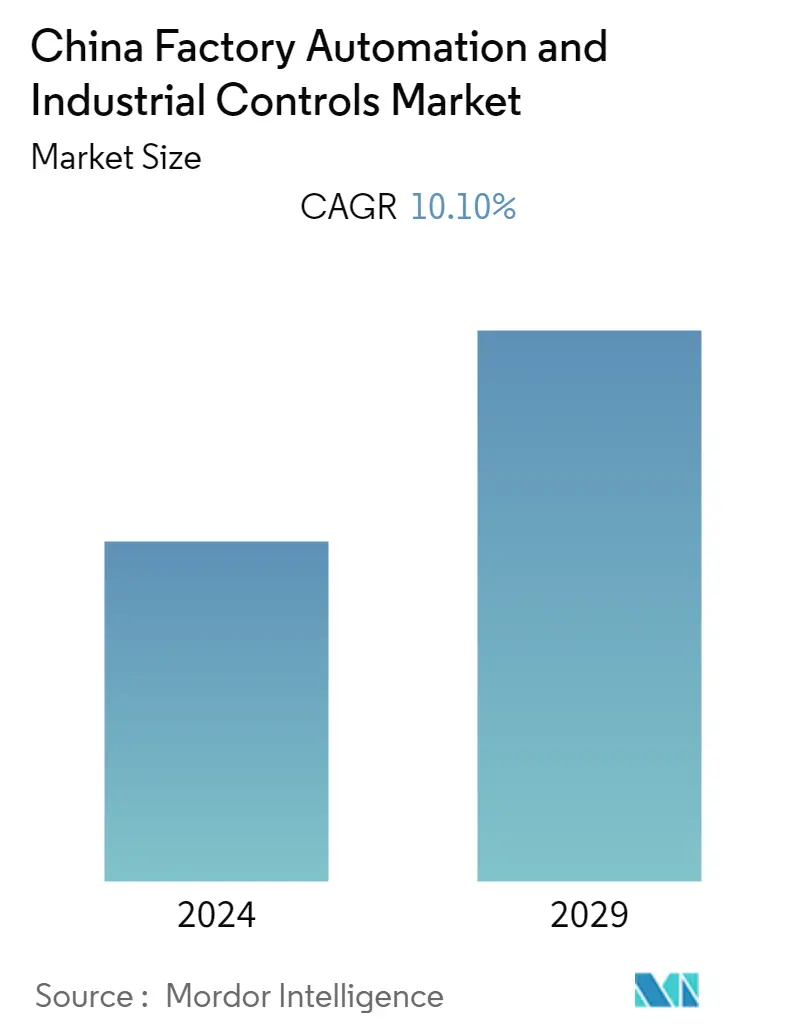Market Size of China Factory Automation and Industrial Controls Industry

| Study Period | 2019 - 2029 |
| Base Year For Estimation | 2023 |
| Forecast Data Period | 2024 - 2029 |
| Historical Data Period | 2019 - 2022 |
| CAGR | 10.10 % |
| Market Concentration | Medium |
Major Players
*Disclaimer: Major Players sorted in no particular order |
Need a report that reflects how COVID-19 has impacted this market and its growth?
China Factory Automation & Industrial Controls Market Analysis
The China Factory Automation and Industrial Controls Market is expected to grow by registering a CAGR of 10.1% over the forecast period. The evolution of technological advancements and innovations across various manufacturing units has encouraged the adoption of automation technologies.
- Digitization and Industry 4.0 initiatives in China have significantly stimulated the growth of automation among industries by necessitating more innovative and automated solutions, such as robotics and control systems, to improve production processes. China's economy witnessed impressive growth due to its manufacturing capabilities and the government's investments in factories, infrastructure, and machinery.
- China has led the industrial robot market, which has driven its way to factory automation in the region. The country is also one of the leading manufacturing countries in the Asia-Pacific region and globally. The increase in shipment of industrial robots in the country and the adoption of various Industrial Control System software across the country facilitates factory automation at scale.
- Automation in China is expected to be augmented by the uptake of intelligent manufacturing. According to the Ministry of Industry and Information Technology, the country initiated over 100 intellectual manufacturing pilot projects in the past few years. Also, in March 2021, the National People's Congress (NPC) approved the outline of the People's Republic of China's 14th Five-Year Plan for National Economic and Social Development and Long-Range Objectives for 2035. The design highlights China's intention to advance its core manufacturing competencies, such as high-end new materials, smart manufacturing, and energy vehicles.
- Government incentives and targets have advanced the potential of the Chinese market to dive into factory automation. Made in China 2025 plan encourages domestic players to decrease their dependency on foreign players. The rapidly soaring labor costs and declining manufacturing labor force supply in China are also helping in the penetration of industrial robots and factory automation.
- The strong support of the government in the acquisition program has helped the country to move towards Industry 4.0. For instance, Siasun, a China-based industrial robot maker, has affiliations with the Chinese Academy of Sciences, which is further linked to the government.
- With the rising cost of production in China and the strengthening of the Yuan against the Dollar, investors have been looking at alternate manufacturing destinations. However, for that, manufacturers need to focus on quality production and environment-friendly manufacturing regulations. A fully automated facility takes years to adjust and evolve with the growing technology. Meanwhile, unfavorable or delayed initiatives on active automation adaption have limited growth on a regional basis.
- China held a monopoly for many years, and supply chains were severely disrupted worldwide as COVID-19 impacted China since the global outbreak. Disrupted supply chains and squeezed revenues led many businesses to realize that their manufacturing needs to be more innovative. Technologies such as artificial intelligence (AI) and the Internet of Things (IoT) are crucial to cutting costs, increasing efficiency, and broadly de-risking manufacturing processes. Once cash builds up, industrial robotics will likely get a tremendous boost.
